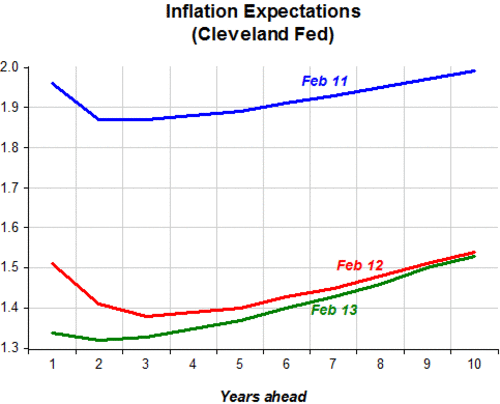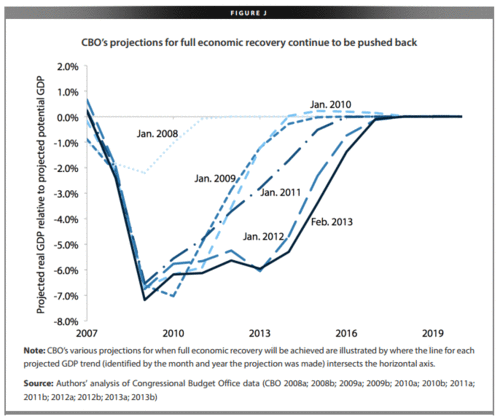
This morning’s key headlines from GenerationalDynamics.com
- Indian Mujahideen suspected in bombing in Hyderabad
- Indian Mujahideen linked to Pakistan’s Lashkar-e-Toiba
- Stock market has ‘mini-panic’ over Fed QE signal
- The Fed’s falling inflation expectations
- Mainstream economists’ failing recovery forecasts
Indian Mujahideen suspected in bombing in Hyderabad

Bomb site in Hyderabad (AP)
Two terrorist bombings killed 13 people and injured dozens others in acrowded marketplace in Hyderabad in India. No one has yet claimedresponsibility, but terrorist group Indian Mujahideen (IM) issuspected. India’s security establishment is coming under criticismfor ignoring the interrogation of an IM operative in Delhi in October.The interrogation revealed three planned sites for terror attacks, oneof which was Thursday’s Hyderabad site.
Indian Mujahideen linked to Pakistan’s Lashkar-e-Toiba
The Indian Mujahideen (IM) was founded by Abdul Subhan Usman Qureshi,who had come from an economically privileged background. and waseducated at a school run by a Christian missionary in Mumbai. Angerat the mainstream media is cited by IM cadres as a motivator. It isargued that the mainstream media turns a blind eye to Hindufundamentalist groups while mostly linking the fundamental nature ofIslam to terrorism. IM is closely linked to Pakistan’sLashkar-e-Toiba (LeT), which supplies weapons and direction to IM. Anobjective of IM is to tie up India’s security forces in India, givingLeT a free hand. Institute for Defence Studies and Analyses (IDSA)
Stock market has ‘mini-panic’ over Fed QE signal
The minutes from the Federal Reserve’s January 29-30 meeting werereleased on Wednesday, and they “hinted” that some people at the Fedwere getting concerned about the massive amount of money that the Fedis “printing” each month. There was a time, before 2008, when $60billion dollars of one-time fiscal or monetary stimulus would havebeen considered an astronomical amount, and would have triggerednational debate. But those days are long gone. For the last year orso, the Fed has been using quantitative easing to inject $85 billiondollars of monetary stimulus EVERY MONTH. The result was a kindof two-day “mini-panic” in the stock market.
I listen to the financial people on CNBC and Bloomberg TV — as muchas I can stand them — and there’s really no longer any pretense thatthe stock market represents anything real anymore. Everyone knowsthat the $85 billion in monthly stimulus hasn’t help any ordinarypeople or small businesses. Instead, it goes to the investment banksand into the stock markets, so that the bankers can continue to paythemselves multi-million dollar bonuses and kick the money back intoObama campaign contributions. So when the Fed hinted that the $85billion might be cut back, the stock market mini-panic began. Bloomberg
The Fed’s falling inflation expectations
If the Fed had “printed” $85 billion per month of new money in the70s, 80s or 90s, then inflation would have skyrocketed. But thosedays are past. As Alan Greenspan has pointed out, every singlestandard macroeconomic model has been completely wrong since 2007.The reason they’ve been wrong is that they’re based on data from the70s, 80s and 90s, when the Silent Generation was in charge. Today,the Gen-Xers and the Boomers are in charge, and the cultureis now one of fraud, extortion, and screwing people. Today’sculture is like the 1930s, and the only macroeconomic modelsthat will work should be base on 1930s data.
The Fed puts out a regular report on “inflation expections” — howmuch they expect inflation to rise in the current year, in thefollowing year, and in each year for the next ten years. Unfortunately,the Fed’s inflation forecasts have been abysmally wrong, year afteryear. Here’s a chart of the Fed’s inflation expectations as ofFebruary in each of the three past years:

Fed ‘Inflation Expectations’ in Feb ’11, Feb ’12, and Feb ’13 (Marcus Nunes)
There are two interesting things about the above chart. One isthat the Fed’s inflation expectations have been falling each year,reflecting the fact that inflation itself has been falling.
The second interesting thing is that the Fed’s models have been wrongevery year in exactly the same way. Each year they predict a briefperiod of falling inflation, then a period of rising inflation. Instead,inflation keeps falling, and expectations keep falling.
Since 2003, I have been writing that, in this generational Crisis era,our economy is in a deflationary spiral. Since 2003, mainstreameconomists have been predicting that there would be inflation orhyperinflation the following year. They’ve been wrong every, and I’vebeen right. Marcus Nunes
Mainstream economists’ failing recovery forecasts
Mainstream economists are always predicting that prosperity is justaround the corner, so that people will buy their stocks or bonds orwhatever. Each month, the Congressional Budget Office (CBO) forecastswhen there will be a full economic recovery. The Economic PolicyInstitute has done a study of the CBO forecasts for the last fouryears, and found that they have failed in exactly the same sortof way that the Fed’s inflation forecasts had failed.Here’s a chart of the CBO recovery predictions for January of eachof the last few years:v

CBO forecasts of full economic recovery, Jan ’08, Jan ’09, Jan ’10, Jan ’11, Jan ’12, and Feb ’13. (Economic Policy Institute)
So, in Jan 2008, the were project full recovery by 2011. By Jan 2011,it would be 2016. And the latest projection, from February of thisyear, puts the forecast of full economic recovery at 2018.
As I’ve written many, many times, mainstream economists have no clueabout what’s going on. They didn’t predict, and can’t explain, thetech bubble of the 1990s, the real estate bubble, the credit bubble,the credit crunch of 2007, the collapse of 2008, they had no idea whatwas going to happen in 2012, and they don’t have the vaguest cluewhat’s going to happen in the next year. Unfortunately, with theGen-Xers increasingly in charge, the worst is yet to come. Washington Post and Economic Policy Institute
Permanent web link to this article
Receive daily World View columns by e-mail

COMMENTS
Please let us know if you're having issues with commenting.